This is the second part of a large article about growing tomatoes in open ground. We recommend that you first read the first chapter, which can be read here. It provides detailed recommendations on choosing varieties for different regions, preparing beds, technology for planting seedlings, a non-seedling method of growing tomatoes and much more.
How to properly grow tomato seedlings read this article
In this article I will try to tell you in detail how to care for ground tomatoes, how to protect them from diseases and grow a decent harvest.
Caring for tomatoes in open ground
After the seeds germinate and seedlings are planted, the greenhouse is regularly ventilated; tomatoes love drafts and do not tolerate stagnant air under the film. In the south, after 2-4 days the shelter is removed, in the north it depends on the weather. In cold, rainy summers, lutarsil is left for the entire growing season, opening the greenhouse in the middle of the day and closing it at night. If the summer is warm, then the covering material is removed.

To prevent plants from lying on the ground, they are tied to pegs
After planting, the plants are tied to stakes. For tall varieties, the support should be at least a meter. When growing tomatoes by direct sowing into the ground, the plants are tied up when they have 5-7 leaves.
How to water tomatoes in open beds
In the north and central regions, ground tomatoes are not watered. They have enough rainfall. And only if there has been no rain for more than 15 days, moderate watering is done. Water tomatoes at the root, as they do not like moisture on the leaves. Watering is always done in the evening before sunset, since the roots absorb moisture better at night. After the soil dries, the bed is loosened and the bushes are hilled.
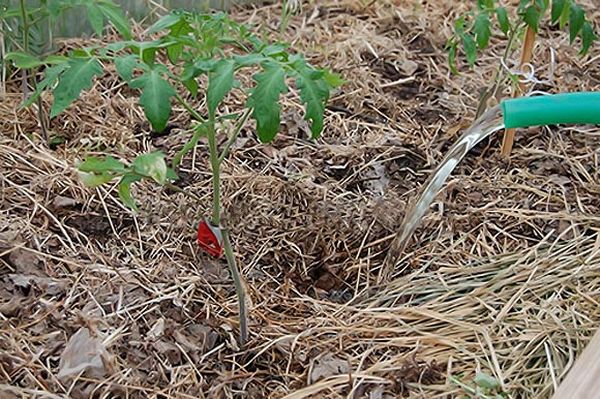
Watering is carried out only at the root.
In the southern regions the opposite is true. During periods of drought and heat, tomatoes require watering, but moderate; they do not like waterlogging of the soil and stagnation of moisture. The frequency of watering depends on the speed of drying of the soil; as soon as it is dry, the tomatoes are watered. The lack of moisture is judged by the color of the leaves: they become dark green, although they still remain elastic. The watering rate for the plant is 5 liters per bush. But they navigate by the weather.In very hot and dry summers, the watering rate remains the same, but its frequency is increased to 2-3 times a week.
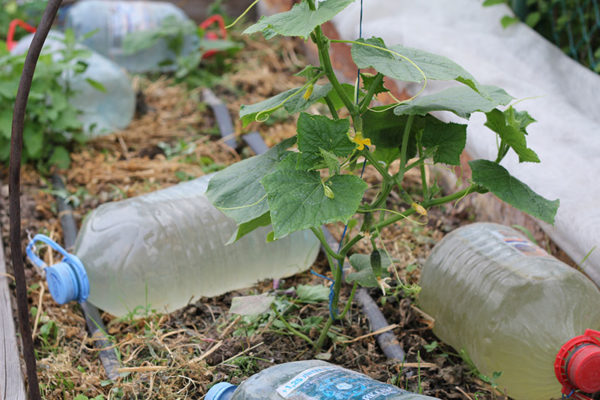
The photo shows homemade drip watering of cucumbers, but you can water tomatoes in the same way.
In the south, the crop responds very well to drip irrigation. With this method, the soil does not become waterlogged, and the tomatoes receive a sufficient amount of moisture. If there is no drip irrigation system, then use plastic bottles. The bottom of the bottle is cut off and stuck with the neck into the ground at a distance of 20 cm from the plant. You can put a nozzle with a narrow end on the neck.
You can make several holes on one side of the bottle, pour in water and place it horizontally with the holes down. 2-3 bottles are placed near each bush; irrigation water is poured into them in the evening, which slowly seeps into the soil into the root zone and is consumed by the tomatoes. It is impossible to immediately water abundantly, as this causes increased growth of stepsons, and during the fruiting period - cracking of the fruits. In case of prolonged drought, water every other day, but little by little.
Feeding ground tomatoes
In open ground, tomatoes are fed every 12-15 days. For normal growth, the crop requires sufficient amounts of phosphorus and potassium. Tomatoes also love nitrogen, but it is given in limited quantities, otherwise they will grow leaves and shoots to the detriment of the harvest.
However, in the south, early ripening varieties can be given 1-2 nitrogen supplements. Semi-rotted manure is most suitable. A shovel of manure is filled with 20 liters of water and left for 5-7 days, stirring regularly. 1 liter of infusion is diluted in 10 liters of water and fertilized.
The emerging stepsons are cut off depending on the variety, leaving 2-3 pieces; it is from them that the second wave of harvest is obtained at the end of summer.For the central and northern regions, organic fertilizing is not suitable, since with the vigorous growth of the tops, the fruits will not have time to ripen, or even set.
- First feeding carried out 10 days after planting the seedlings. This is either fertilizing with organic matter (in the south) or with complex fertilizer for tomatoes and peppers (Malyshok, Krepysh).
- Second feeding carried out after the formation of the first brush. Complex fertilizers are used (Kemira universal, Mortar, Nitroammofoska). Fertilizers should contain magnesium, boron, and calcium. You can prepare the mixture yourself: 2 tbsp. azofoski, 1 tbsp. superphosphate (on alkaline soils use double (it slightly acidifies the soil), on acidic soils - simple), 1 tsp. potassium sulfate (1/2 tsp potassium sulfate) or kalimag, boric acid 5 g. Mix everything, 3 tbsp. dissolve in 10 liters of water and fertilize. If tomatoes grow poorly, then 10-15 ml of humate or 1 liter of herbal infusion can be added to the solution.
- Third and subsequent feeding made with the same fertilizers. During fruit formation, bushes require sufficient amounts of potassium and phosphorus. The fertilizing must contain calcium; if it is lacking, blossom end rot of the fruit appears.
Feeding is stopped when the tomatoes are finished. When growing indeterminate varieties in soil, feed the plants every 10 days.
Among folk remedies, ash infusion is often used: 1 liter of infusion per 10 liters of water. The consumption rate is 5-7 liters per bush. In the southern regions, root feeding alternates with non-root feeding. In the north, early-ripening tomatoes are grown in open ground and the plants are not sprayed on the fruits that have set.
There is a recommendation to feed tomatoes with yeast. But yeast does not contain any substances suitable for culture growth.They are antagonistic to some soil fungi, but these pathogens do not affect tomatoes.
Therefore, their use on crops is useless.
Formation of bushes
Formation depends on the growing region and variety. On north and center Indeterminate varieties of tomatoes are not grown in soil.
Semi-determinate varieties - tall, they lay at least 5-6 brushes. After this, the plant can continue to form clusters, but at any moment it can end, and the growth of the bush will stop. Therefore, it is grown in 2-3 stems, but often it is not possible to harvest from such tomatoes because summer is ending. Half-children are practically not grown in open ground.
Determinate varieties stepsons are taken very carefully. All stepsons are removed up to the first brush, and then 1 shoot is left. After the formation of the third brush, you can leave another stepson. These are fast-growing tomatoes, and during warm and long summers, the second wave of the harvest manages to begin on the side shoots.
Ultra-determinate, ultra-early fruiting tomatoes they do not plant stepsons, since the main harvest is taken from the stepsons. If you pick off all the stepsons, then the only thing you can get from the bush is 3-5 small fruits.
Formation of tomato bushes in the southern regions
All types of tomatoes are grown here in the open ground.
Indeterminate tomatoes lead into 2-3 stems, tying them to a trellis. The strongest stepson is left under the first brush, which eventually turns into the second stem. After 3-4 leaves, another stepson is left, which also forms into an independent shoot. At the end of July, you can leave another shoot, giving it the opportunity to develop normally. With this formation, the fruits in the south are harvested until mid-September.
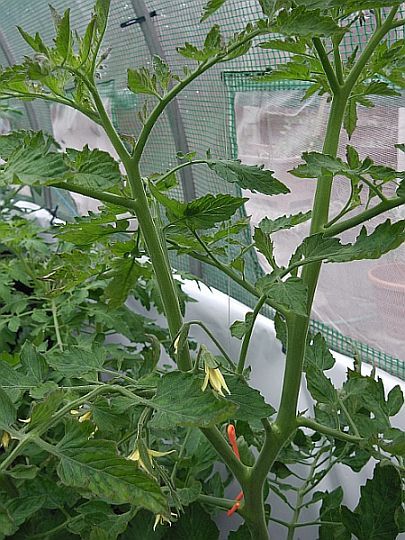
Forming a tomato bush into 2 stems
Semi-determinate varieties pinch slightly, removing the stepsons up to the first flower cluster, and plucking the rest through one leaf. As a result, a lush bush grows, strewn with fruits.
Determinate varieties do not form, allowing them to grow and branch freely. They produce an early harvest of tomatoes.
Ultradeterminate varieties It is not advisable to grow tomatoes in the south, since the yield from them is small, the tomatoes are small, and they finish the growing season very early.
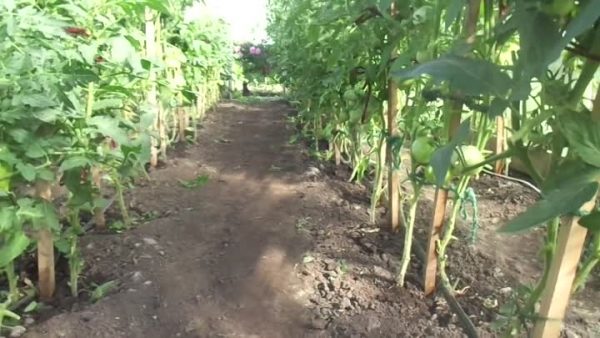
All lower leaves must be removed
Regardless of the growing zone and variety of tomatoes, all leaves up to the first flower cluster are removed. Then, as new clusters form, the lower leaves are removed so that there are no leaves under the knotted cluster. If the tomatoes are finished, then leave 2-3 leaves under the top brush. Plants cannot be left completely without leaves.
Increased yield
To improve fruit set, shake tomatoes every 1-2 days. If the weather is cool for a long time (12-16°C), then the pistil of the flowers is stretched and pollination does not occur. Then they are pollinated by hand, transferring pollen to the pistil using a brush.
In hot weather (above 32°), the pollen becomes sterile, so you need to shake the bushes at night.
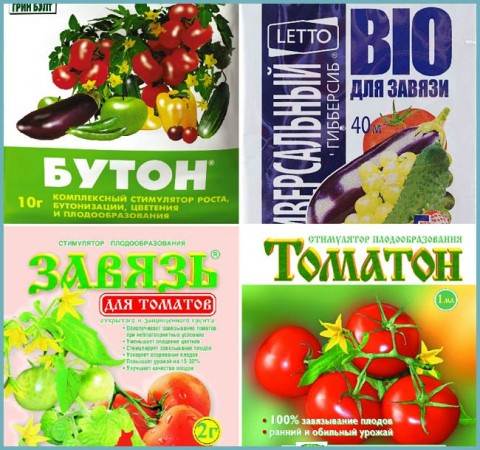
Growth stimulants
If the weather is unfavorable for a long time (too hot or cold), then spray with growth stimulants Bud, Ovary, Gibbersib, Gibberelin, Tomaton. The drugs stimulate fruit set without pollination.
Harvesting
In the middle zone, ground tomatoes are picked brown or green. They do not have time to completely turn red on the bush. The fruits are ripened in boxes.Light does not affect ripening, but at temperatures below 12°C, the production of the enzyme that colors tomatoes red stops. At this temperature they turn pale yellow.
The same thing can be seen on the bushes: fruits left on the plant until fully ripe do not turn red, but bleach, acquiring a yellowish tint. If the temperature rises, enzyme production will resume and the tomatoes will turn red.
It should be noted that in the middle zone, despite the highest agricultural technology and careful care, tomatoes will still be sour. You won't be able to grow sweet southern tomatoes here. In order to accumulate sugars, tomatoes need a high average daily temperature (at least 20°C at night) and hot sun. But this does not exist in this region.
You can speed up the ripening of fruits by completely stopping watering and covering them with film when it rains. It is also necessary to cut off some of the roots by deep loosening the bed. This reduces plant nutrition, slows growth and accelerates ripening.
In the case of tall varieties, the top, flowers, buds and all emerging stepsons are cut off. This allows you to speed up ripening by 5-7 days.
Problems when growing ground tomatoes
The main problem in care is the early damage to tomatoes by diseases. In the ground, the crop is affected by late blight, and in the south, in addition, by cladosporiosis.
Late blight ground tomatoes are affected very early, especially when adjacent to potatoes. To prevent disease, the distance between crops should be at least 200 m. But in a small area this is almost impossible to do.
The only preventive measure is spraying both crops with copper preparations (HOM, Oxychom, Ordan). Copper-containing preparations are alternated with Previkur or Consento.Treatments are carried out at intervals of 10-12 days throughout the entire growing season, alternating chemicals. Solutions of these drugs are spilled on the soil under the tomatoes.
Phytophthora later appears where copper is present, so tomato stems are wrapped with copper wire. Wire can also be inserted between potato hogs.
But, despite all the measures, late blight will still appear in the open ground. The only question is timing. The later the disease appears, the greater the harvest you can get.
Cladosporiosis severely affects ground tomatoes in the south. In the middle zone in open ground, the disease is rare. Since the disease begins with the lower leaves, their timely removal reduces the risk of the disease. For prevention, treating bushes with Pseudobacterin is a good option. Treatments are carried out 3-5 times per season with an interval of 7-10 days.
When the first signs of the disease appear, the affected leaves are removed and the tomatoes are treated with copper-containing preparations.
In the middle zone, it is much more difficult to get a good harvest of ground tomatoes than with greenhouse cultivation. Often the efforts are not worth it. Therefore, greenhouse cultivation is preferable here. In the south, on the contrary, it is better to grow tomatoes in open ground, covering them with spunbond on cold days. With the right selection of varieties and proper care, two harvests are harvested here per season.
Continuation of the topic:
- Schemes for feeding tomatoes in a greenhouse and exhaust gas
- Growing tomatoes Bull's heart
- The most dangerous tomato diseases and methods of treating them
- What to do if tomato leaves curl
- How to pick tomatoes correctly and why to do it
- Rules for planting tomato seedlings in a greenhouse
- Caring for tomatoes in a greenhouse
- How to protect tomatoes from late blight
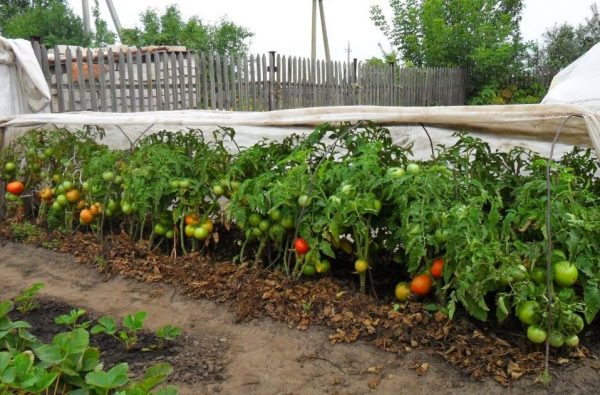
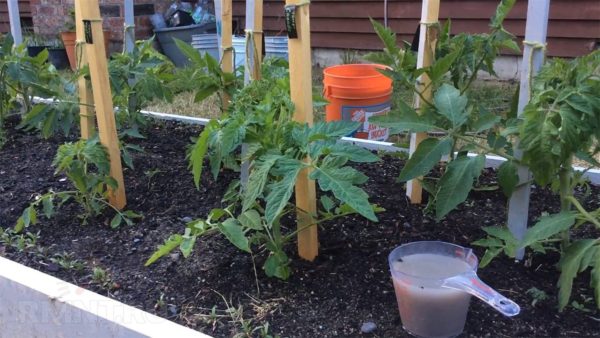
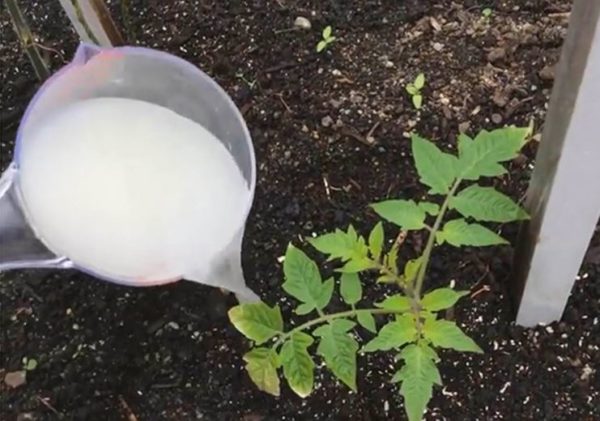

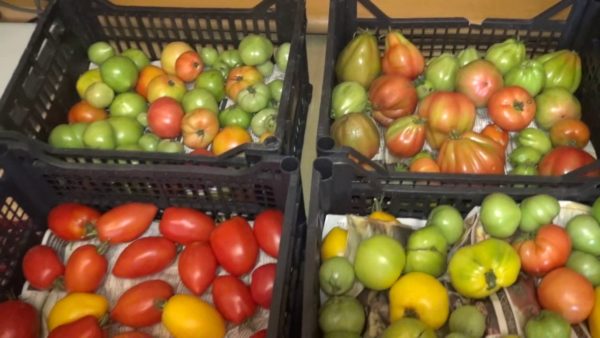
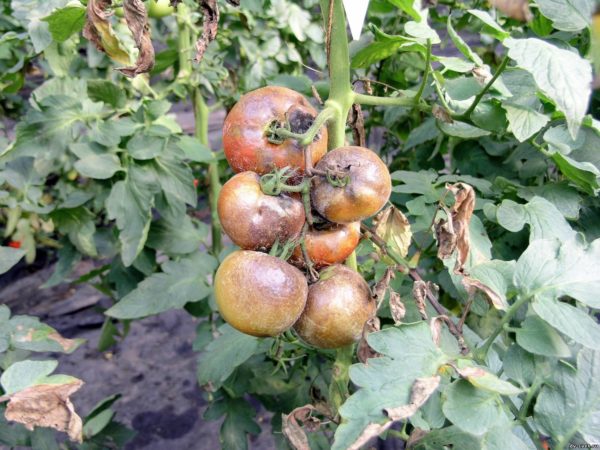


 (8 ratings, average: 3,75 out of 5)
(8 ratings, average: 3,75 out of 5) CUCUMBERS NEVER GET SICK, I'VE BEEN USING ONLY THIS FOR 40 YEARS! I SHARE A SECRET WITH YOU, CUCUMBERS ARE LIKE THE PICTURE!
CUCUMBERS NEVER GET SICK, I'VE BEEN USING ONLY THIS FOR 40 YEARS! I SHARE A SECRET WITH YOU, CUCUMBERS ARE LIKE THE PICTURE! You can dig a bucket of potatoes from each bush. Do you think these are fairy tales? Watch the video
You can dig a bucket of potatoes from each bush. Do you think these are fairy tales? Watch the video
 How our fellow gardeners work in Korea. There is a lot to learn and just fun to watch.
How our fellow gardeners work in Korea. There is a lot to learn and just fun to watch. Eye trainer. The author claims that with daily viewing, vision is restored. They don't charge money for views.
Eye trainer. The author claims that with daily viewing, vision is restored. They don't charge money for views. A 3-ingredient cake recipe in 30 minutes is better than Napoleon. Simple and very tasty.
A 3-ingredient cake recipe in 30 minutes is better than Napoleon. Simple and very tasty. Therapeutic exercises for cervical osteochondrosis. A complete set of exercises.
Therapeutic exercises for cervical osteochondrosis. A complete set of exercises. Which indoor plants match your zodiac sign?
Which indoor plants match your zodiac sign? What about them? Excursion to German dachas.
What about them? Excursion to German dachas.
Very interesting article about growing tomatoes.
Olina, I am very glad that the article was useful to you.